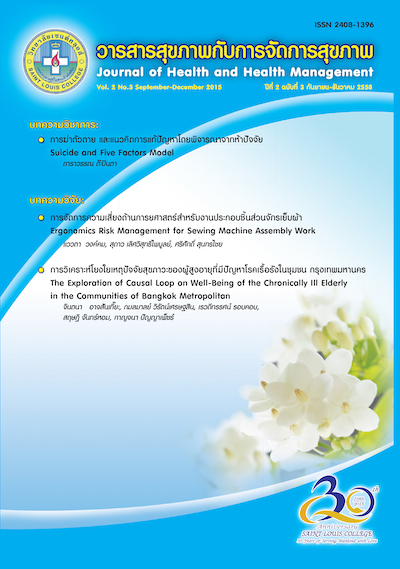The Exploration of Causal Loop on Well-Being of the Chronically Ill Elderly in the Communities of Bangkok Metropolitan
Keywords:
community, causal factors, well-being, chronically ill elderlyAbstract
The purposes of this study were to 1) explore the level of the well-being of the chronically ill elderly, 2) analyze the effects that were related to the well-being of the chronically ill elderly, and 3) synthesize the casual factors effect to the well-being of the chronically ill elderly in the communities of Bangkok Metropolitan. The study samples consisted of 1,000 chronically ill elderlies who living in four areas of Bangkok (Klongteay, Yannawa, Bangklolem, and Bangkhuntean), were selected by using the Stratified random sampling. Data were collected by interviewing with the questionnaire, containing 2 parts: the well-being and the factors effected well-being in the frame of PRECEDE PROCEED, with the reliability values of 0.83. Data were analyzed by using frequency, percentage, mean, standard deviation, PATH analysis and validation of the model. The results of this study showed that: 1) the chronically ill elderly in the communities of Bangkok Metropolitan had high level of well–being. 2) The causal factors that was related to overall well-being of the chronically ill elderly in the communities, were the ecological factors, with the direct effect coefficient = 0.645, and direct effected to overall well–being in social and economic aspect, family aspect, psychological and spiritual aspect, and physical and functioning aspect, with the direct effect coefficient = 0.715, 0.666, 0.678 and 0.599, respectively. 3) The study model indicated that the goodness of fit test was 0.977 for Goodness of fit index (GFI), 0.971 for Adjusted goodness of fit index (AGFI), and explained the well-being on the life of the chronically ill elderly in each aspect as follow: 76.60% of the social and economic aspect, 72.30% of the family aspect, 73.40% of psychological and spiritual aspect, and 48.50% of physical and functioning aspect.
References
ปัณณทัต บนขุนทด. (2554, มกราคม). ผลการสำรวจ พฤติกรรมสุขภาพของผู้สูงอายุ ตำบลบ้านทุ่ม อำเภอเมือง จังหวัดขอนแก่น. การประชุม วิชาการ มหาวิทยาลัยขอนแก่น ประจำปี 2554 “การพัฒนาอนาคตชนบทไทย: ฐานรากที่มั่นคง เพื่อการพัฒนาประเทศอย่างยั่งยืน”. ขอนแก่น: มหาวิทยาลัยขอนแก่น.
สิริพร สุธัญญา. (2550). พฤติกรรมการดูแลตนเองกับ ความพึงพอใจในชีวิตของผู้สูงอายุในสวนรมณี นาถ กรุงเทพมหานคร. (สารนิพนธ์ปริญญาการ ศึกษามหาบัณฑิต สาขาวิชาจิตวิทยาพัฒนาการ). กรุงเทพฯ: บัณฑิตวิทยาลัย มหาวิทยาลัย ศรีนครินทรวิโรฒ.
สุรเดช ดวงทิพย์สิริกุล. (2557). สังคมผู้สูงอายุ...กับความ ท้าทายการจัดการด้านสุขภาพ. โครงการ ประเมินเทคโนโลยีและนโยบายด้านสุขภาพ, 2 (17), น. 1-3.
ศิริวรรณ ศิริบุญ และชเนตตี มิลินทางกูร.(2553). การ พิทักษ์ผู้สูงอายุ สืบค้นวันที่ 20 พฤษภาคม 2556, จาก www.oppo.opp.go.th/info/Re port_299.pdf
วิชัย เสนชุ่ม, พฤฒินันท์ สุฤทธิ์, ณรงค์ศักดิ์ หนูสอน, และ ธนัช กนกเทศ. (2554). ปัจจัยพยากรณ์บทบาท ของสมาชิกครอบครัวในการดูแลและส่งเสริมสุข ภาพผู้สูงอายุ ตำบลพะวอ อำเภอแม่สอด จังหวัดตาก. วารสารการพยาบาลและสุขภาพ,5(2), น. 23-33.
อรนุช คงเหลี่ยม. (2552). ปัจจัยทางชีวสังคมและความ เชื่ออำนาจควบคุมด้านสุขภาพที่มีผลต่อ พฤติกรรมการดูแลสุขภาพตนเองของผู้ป่วยโรค เบาหวานที่มารับการรักษาที่โรงพยาบาลชัยนาท จังหวัดชัยนาท. (สารนิพนธ์ปริญญาการศึกษา มหาบัณฑิต สาขาวิชาจิตวิทยาพัฒนาการ). กรุงเทพฯ: บัณฑิตวิทยาลัย มหาวิทยาลัย ศรีนครินทรวิโรฒ.
Dunning, T. (2010). Chronic disease self-management: what do we measure?. Journal of Nursing and Healthcare of Chronic Illness, 2(4), pp. 251-253.
Green, L.W., Kreuter, M.W. (1992). CDC’s Planned approach to community health as an application of PRECEDE and an inspiration for PROCEED. Journal of Health Education, 23(3), pp. 140-147.
Phillips, J. L., Rolley, J. X., & Davidson, P. M. (2012). Developing targeted health service interventions using the PRECEDE-PROCEED model: Two Australian case studies. Nursing Research and Practice, 8.
Tramm, R., McCarthy, A., & Yates, P. (2012). Using the Precede–Proceed model of health program planning in breast cancer nursing research. Journal of Advanced Nursing, 68(8), pp. 1870-1880.




